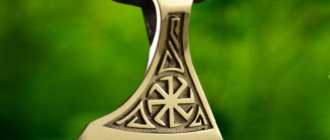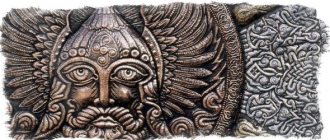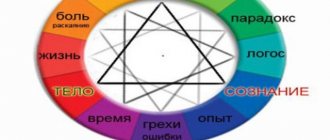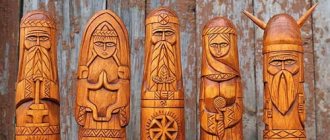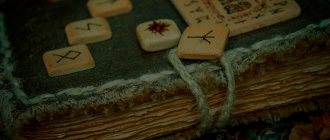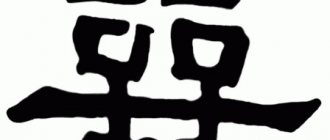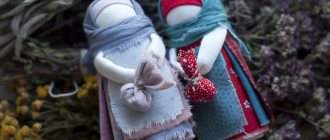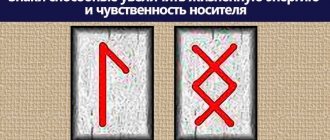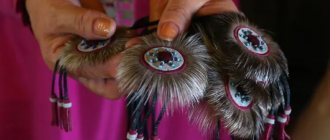Perunitsa - divine spear-bearing maiden and symbol of Perun
Perunitsa is a definition with many interpretations.
This is what they called lightning in the old days, which were considered one of the symbols of Perun. The warrior maiden of divine origin had the same name. Slavic mythology calls her the wife, and sometimes the daughter, of a formidable deity. Perunitsa or, as she is also called, Gromovitsa or Magura, was a warrior on the battlefield in the form of a beautiful girl with a spear, inspiring them to feats of arms. Image of Perunitsa (Gromovitsa) - wife of Perun
Perunitsa is also a symbol of Perun, one of many Slavic signs related to this deity. Its appearance is similar to lightning - the main weapon of the thunder god and is depicted in the first picture of the article. For a long time, featherweed has been worn as a talisman. It protects from the evil eye, damage and the machinations of enemies, adds confidence to those who lack it, and relieves worries and doubts.
The amulet is suitable for both men and women, because the Perunitsa symbol is dedicated to both the god Perun and the warrior maiden Magura. It adds courage, confidence and energy to move towards goals and fight against circumstances. Perunitsa accelerates events and gives the impetus necessary for the further development of a person. In addition, it is capable of rejuvenating both externally and internally, making a person able to preserve his inner child.
In general, perunitsa is a good amulet for a person who holds the position of boss, judge, lawyer or manager. Often there are amulets in the form of a bird's eye surrounded by the star of England. The latter strengthens any Slavic amulet if inscribed around it.
Bird
The integral attributes of the thunder god also include Perun’s Bird, which was usually depicted with an open beak from which flames burst out and a loose tail. Such a sign was presented to the Slavic warrior by his wife or mother in the form of a pendant or ring. The woman also embroidered a pattern in the form of a bird on a shirt or cloak.
During the battle, the Bird of Perun provided powerful protection from an enemy sword or arrow. In peaceful life, such a talisman gave the owner courage and determination to implement his plans. In addition, the said amulet provided:
- success in acquiring material wealth;
- protection from damage, the evil eye and other negative influences;
- development of independent thinking and high moral qualities in a man;
- strengthening willpower and fighting spirit.
It was believed that such a talisman contributed to the birth of a son if the future parents wanted it.
Shield of Perun - amulet of noble warriors
In the old days, only warriors from a noble family, as well as leaders of troops - military men holding high positions, as well as state rulers had the right to wear Perun's shield. Now there is no such restriction, because every military man can be called a noble person - he enjoys constant respect and honor in society.
Beliefs say that this shield protects from enemy arrows and spears. Nowadays such weapons are no longer used, and the belief has changed somewhat. Modern military men believe that such an amulet will protect against a knife and a bullet.
The Slavs wore the shield of Perun not only in order to return home safe and sound after the battle. Our ancestors believed that it protects against any troubles of a magical and material nature.
Shield
The Shield of the Thunderer was no less popular among the Slavs. Symbolically, it looks like a drop, the sharp end of which is directed downward. If a craftsman took on the task of making an amulet, he would put the image of God himself on the Shield.
On the Shield they painted the Thunder symbol and the weapon of God: an ax, a sword or a lightning bolt.
The Shield of Perun belongs to the category of exclusively male amulets. Women should not resort to his help even in exceptional cases. In ancient times it was a distinctive sign of the knight class, and even now it will primarily benefit military personnel.
The properties of the amulet are contained in its name. This is a shield that protects a warrior in battle. In a broader sense, it is a shield against the effects of negative energy. It protects not only the owner of the amulet, but also his family and his clan.
Perun's thunder wheel, or thunderer - a patriot's talisman
Amulet with the wheel of Perun
Perun's thunder wheel is a protective symbol that works only for those people who sincerely love their native land. The highest values of the owner of such a talisman should be honor and duty to the residents of his state. Therefore, it is considered the best amulet for a politician, firefighter, policeman or military man.
The main meaning of the Perun wheel amulet is the development of courage, determination and the revelation of spirituality. It helps you make decisions in difficult situations and emerge victorious. This amulet will protect you from life’s troubles and help you do your job better.
The wheel of the god of warriors, or the thunderer, has long been considered a male talisman. A young man could receive one as a gift from his father or older brother, as a wish to grow up to be a real man. This is what happened most often, given the significance of this amulet of Perun. A woman can also wear it, but only during the period when she needs masculine qualities. If you wear a thunderclap all the time, you can part with your feminine character traits forever.
Appearance, attribute meanings and photos
The symbol of Perun is similar to a sword or ax, and an ax . There are amulets and ritual embroideries on clothes; the most frequently embroidered of them was the Color of Fern.
Basically, the symbols of Perun were recommended to be worn by male representatives. But there are always exceptions, and the female sex, wanting to receive masculine qualities from the Thunderer, such as courage and perseverance, also used his signs.
When choosing talismans and amulets for yourself with the symbol of Perun, pay attention to their specific meanings, which will be described below, and the talismans are presented in the photo.
Thunderman or Thunder Wheel
Gromovik or Gromovnik is the main symbol among the others that relate to Perun. It is also called the Wheel of Perun or the Thunder Wheel. In the photo it is depicted in the form of a six-pointed cross with blades extending from the center, closed in a circle. This sign resembles the six-rayed Kolovrat .
Perun among the Slavs resembled Zeus among the ancient Greeks. He was portrayed as a tough defender of people against injustice. The Thunderer gave people strength to move forward.
The meaning of Gromovnik is as follows:
- provides an opportunity to gain confidence;
- helps to gain body strength;
- renews joy in life;
- protects from enemies in war and in life;
- protects from damage.
The thunderbolt as a talisman is suitable for young men and men who revere it as a symbol of the fire of life. Women mainly used it as a talisman for home and family. It is not recommended for children - it is too militant and bright.
Ax (sokira)
Perun's ax in the photo looks like an ax with a wide, solid, equilateral blade in relation to the handle. This symbol was worn only by those who belonged to the prince's squad or warriors. This amulet was made from various materials: iron, bronze, silver and lead.
The most common are two types of Ax amulets with one or two blades. Engraving patterns can be on one or both sides; they relate either to the Thunderer himself or to his ancestors Lada and Svarog.
This talisman bestows and protects:
- Confidence in your strength;
- good health and body;
- good luck in business and work;
- physical strength;
- protects against the actions of enemies in battle and in peace.
Men were awarded such badges for military merit . The amulet of the Ax of Perun indicates that the owner has the strength and military skill of the ancient militant Slavs. Children are not recommended to wear this sign of the Thunderer. Women are also forbidden to wear it, as Sokira is full of masculine assertiveness and strength.
Star of Perun - symbolism of a protective nature for a defender and judge
Star of Perun
The Star of Perun, like most protective symbols dedicated to this deity, is not intended for everyone. Such a talisman can be worn by a person who is considered a defender or arbiter of justice. In the old days, these were the military, guards, and also the rulers of the state.
Now the Thunderer's star can become a good amulet for a judge. It will help you make the right and fair decision, preventing a criminal from going unpunished and an innocent person from ending up behind bars. This talisman is also good for a policeman or prosecutor.
In addition, such a star will be an excellent amulet for a person who is at the origins of any business. If you are the leader of any team or enterprise, your professional activity is related to management, justice is inherent, then this talisman will help you better cope with your professional responsibilities.
This symbol is often called differently - the cross of Perun, but these are different symbols. The cross looks like a four-pointed star. Not much is known to modern people about this protective symbol. This symbol, according to legend, bestowed the favor of the deity on representatives of the specialties that he patronized.
Capabilities
Based on the fact that Perun was a thunderer, he knew how to cause strong thunderstorms. God not only threw lightning for his own pleasure: with their help he punished people who angered him. Usually the unwanted ones were burned alive on the spot. Those who managed to survive were considered almost saints. The lucky ones were called “marked by Perun”, because after the incident they usually discovered hidden magical powers, healing skills and extrasensory abilities.
And Perun himself, the god of thunder and lightning, was an excellent magician. He flew across the sky in a chariot and knew how to transform into different animals, birds, and people. At his own request, he created ghostly creatures, which he sent to mortals with a specific mission. In addition, Perun had enormous physical strength; it was not for nothing that he was compared to an oak tree. By the way, the Slavs were so afraid of the Thunderer that they never cut down these trees. They revered the oak tree that was struck by lightning with double rapture: the wands and clubs cut from its trunk were considered the best weapons not only in the battle with mortal enemies, but also with magical creatures from the afterlife of Navi.
Perun's sword is a symbol of justice
Ancient amulet - Perun's sword
The sword of Perun is not only a symbol, but also a weapon used by the deity to restore justice. Perun is a warrior god, and he patronizes only people who are ready to fight, albeit not always in the literal sense of the word.
With the sword of Perun you can remove illness, the evil eye, damage or a curse if you are sure that you do not deserve such punishment. The test of adversity of a magical nature is well deserved, then the symbolism of Perun will not help - he values honesty and justice.
In addition, the sword can bestow wisdom on its owner. If you want to work on qualities such as honor, dignity, courage and determination, this amulet is perfect for you. It is able to eliminate chaos and helps achieve order in all areas of life. Having the sword of Perun, you can quickly restore order in all matters that you had never gotten around to before.
What does the Rune of Perun mean?
Rune of Perun
The history of the Slavic runic alphabet goes back to ancient times. Our ancestors believed that with the help of magical symbols it was possible to control natural forces and ward off misfortunes. These sacred symbols carry a powerful energy charge, so you should not use them thoughtlessly, otherwise you can harm yourself. The Slavs knew well and skillfully used such magic. Protective symbols were embroidered on clothes, painted on the walls of houses and dishes. Amulets were made from stone, wood, and bone. The rune represents an undertaking; it will help bring any difficult task to completion. Promotes changes for the better, attracts individuals with good energy and transforms the worldview of the person himself. Develops leadership qualities in the owner, which allows him to move forward and improve. The main thing is to direct new opportunities to good deeds, otherwise the magic of the sacred sign can destroy the psyche of its owner. The drawing of the Rune means the victory of truth over lies, light over darkness.
Seal of Perun - a strong male amulet
If some of the amulets described above could also be worn by women, then the seal of Perun is an exclusively male amulets. In the old days, an amulet with her image was received as a gift from beloved women as a sign of respect for the owner of the house, the head of the family and the defender of the fatherland. The Seal of Perun is a talisman that can be worn by a young man. Our ancestors believed that wearing such a talisman from childhood allows you to grow up bold and courageous.
The seal of Perun is capable of imparting truly masculine character traits - courage, perseverance, courage, determination. It was worn not only by warriors, but also by representatives of other specialties. The seal of the formidable deity of thunder and lightning can protect against enemy intrigues, death and injury on the battlefield. This is true not only for men who go to war.
Modern battles increasingly take place in peacetime in the form of office intrigues, wars between neighbors and other unpleasant clashes of interests. The seal of Perun will protect you from enemies, the evil eye and damage. It will be an excellent amulet for any person who has ill-wishers. In addition, this protective symbol is perfect for people whose purpose is to bring justice, for example, judges or lawyers.
Perun's opposition to the forces of chaos and darkness
It’s in vain that we forget the valor of times past and keep our way to God knows where. Looking back, we say that we are ashamed to know Nav, Reality and Rule and to know and comprehend both sides of our existence
Veles' book." Part III. "Busovo broadcasting"
According to the mythological legends described in the “Songs of the Bird Gamayun”, Perun was born in bright Iria by the goddess Lada Mother. Tempered by the fire that burned in the Svarog Forge, he received from his father Svarog a thunder club and a fire-maned horse, an assistant in military exploits. The personification of the dark forces of Navi and the creation of evil in those days was the Skipper-beast, he had a lion's head, copper wool, horns, damask hooves, and on his tail there was a poisonous scorpion sting. He dragged the Perunov sisters: Lelya, Zhiva and Morena into the kingdom of darkness, depriving the open world of summer, spring and winter. Yes, for three hundred years and three years the god Perun was hidden from the world of light. Chaos reigned on earth, and people asked the omnipotent gods to deliver them from the Skipper and restore order in the manifest world. After this time, Mother Sva, Mother Lada, shone in the bright sky and called on the almighty Svarog, so that the gods would find Perun and return him to the open world, for only Perun’s light power could defeat the Skipper-beast generated by darkness. The Irian gods began to look for Perun, but the god Perun was hidden underground, however, following the signs indicated by Perunov’s horse, his devoted assistant on earth, and the heavenly eagle - Perun’s faithful companion in heaven, the gods found the cave in which the ruler was hidden of darkness Skipper god Perun.
The gods awakened Perun from sleep with life-giving water, and the sacred surya, the bird Gamayun brought from the Riphean mountains, gave Perun a drink, and she filled him with great power. Then, flashing with bright lightning and breaking apart the menacing clouds with a thunderclap, Perun rushed off on his faithful horse to look for Skipper, the ruler of the dark kingdom. Perun rode on a mighty horse along the roads between the worlds, and the heavenly law affirmed along the way. Arriving in the kingdom of darkness, where Skipper ruled, he freed his sisters Perun from the spell of the fierce beast. The dark beast could not seduce the spirit of the pure god, the bright and righteous Perun, he promised mountains of gold, all his power, so that the formidable Perun could rule the whole of heaven with its help, but Perun rejected all his treacherous gifts, for that gold, washed with human blood, was wrong, and the power of Skipper, generated by Krivda, was not needed by the fair god Perun. Perun defeated the Skipper-beast in battle, freed the open world from his dark dominion, and re-established order on earth and heaven.
When the time came for the terrible and fair god to marry, he chose the goddess Diva-Dodola as his military companion, the inspiration for feats of arms. But the king of the sea, the Black Sea serpent, the three-headed creature of darkness, living in the underwater white-stone kingdom, wanted to take away his beloved Perunova, the beautiful-faced one. Driving his golden chariot harnessed by eight mighty horses, he advanced in darkness onto the Irian garden and demanded that Svarog give him Diva-Dodola as his wife. Turning into a gray eagle, Perun flew in, and all the power of heaven gathered to help - Veles, Stribog, Semargl, Khors - in order to drive the snake out of the monastery of the most pure Svarga, then he fled to the bottom of the sea, and plunged into darkness and darkness forever and ever. Thus, the gods of the bright Iriy, led by the brave Perun, defeated the offspring of the dark kingdom of the sea - the fierce serpent.
Perun god of the Slavs in ancient chronicles
In addition to the chanting of the valiant deeds of the god Perun in the sacred ancient legend “Songs of the Bird Gamayun”, the oldest primary source of knowledge about the past and the sacred scripture of our ancestors “The Book of Veles” also has its own tale about him. Here he appears as the patron god of warriors and farmers, he is glorified as a god who disperses darkness and illuminates the eyes with divine light, shining with his sword, striking down the enemy with it. It is said that they turned to Perun for support in times of cruelty, when foreigners attempted to seize our lands, for he is a god, calling with ardent heavenly thunder to a righteous battle against the invaders. He is also glorified as a god whose power encourages the earth to bear fruit, shedding rains that are sent to the earth by the will of Perunova. He is called the giver of blessings, comforter and protector, Father and Leader.
The Tale of Bygone Years, dating back to the beginning of the 12th century, tells the story of how the idols of six gods were installed by Prince Vladimir, among whom Perun was the main one. The Slavic god Perun was considered the supreme deity of Kievan and Novgorod Rus'; he headed the pantheon of gods of ancient Rus', among which Khors, Dazhbog, Stribog, Semargl and Makosh are also mentioned in the Tale of Bygone Years. The chronicle also tells of the conclusion in 6415 (907 AD) of a peace treaty with the Greeks, sealed by Prince Oleg and his squad with an oath of arms and the name of the gods Perun and Veles.
Mentions of the god Perun are also found in Christian chronicles, such as the “Novgorod First Chronicle of the Younger Edition,” dating from the end of the 11th century, which states that in 6488 (980 AD) with the beginning of the reign of Vladimir in Kyiv , a wooden idol of Perun with a silver head was installed on the top of the hill. It also talks about the time when Vladimir began to eradicate the original faith of the ancestors in Rus' in 6496 (988 AD): the idols of the gods were thrown into rivers, they were chopped up or set on fire. Unprecedented cruelty was shown to the idol of Perun: he was tied to the tail of a horse and dragged from the mountain to the river, while they beat him with rods, after which they dragged him along the river to the Dnieper. All this action was carried out for show in front of the people, who were saddened by the bitterness of watching what was happening.
Therefore, Prince Vladimir could not destroy the people’s faith in the gods - back in the 14th century, the clergy of the Christian church complained that in the outskirts they still continued to worship the god Perun. Back in the 18th century, during a drought, the Bulgarians held rituals with young people going home, singing and glorifying Perun, and people called on him to wash the parched land with blessed rain. Researcher of Russian and Slavic folklore A. S. Famintsyn in his book “The Deities of the Ancient Slavs” cites the memories of the German traveler Johann Wunderer about visiting Courland in 1613, where he discovered not a Christian church, but a sacred tree - a majestic oak, which was the center of worship for Latvians and was called by them as “Perkunov Oak”.
Analogies in other beliefs
Over the millennia that have passed since the exodus from the northern ancestral home, also as peoples and ethnic groups settled, there was an inevitable transformation of the original unified faith and endowing it with special characteristics and unique features characteristic of each people, caused by both the new habitat and new living conditions. However, in the mythological tales of different peoples today, one can find obvious similarities in plots telling about the confrontation between darkness and light, the personification of chaos and cosmic world order. The identity of the general Indo-European mythological plot about the struggle of the thunderer, who is the force that orders space, is traced, with a snake or a creature of the serpentine breed - the personification of chaos, destroying order and harmony in the universe. Thus, the thunder god acts as an antagonistic force to chaos, darkness, inertia and passivity.
However, even in the names of some gods, not only etymological similarity can be traced, but also the identity of the basis - the root. Thus, the name of the thunder god Perun is consonant with one of the epithets of the god of gods of the Vedic pantheon, the thunder god and leader of the army of Indra - “Parjanya”, under this name Indra appears in the Vedas in one of his aspects - as the god of thunderstorms and rain. Parjanya (Sanskrit: पर्जन्य) means 'rain' or 'rain cloud' in Sanskrit. Some hymns appeal to him for protection, and he is described as roaring like a bull and racing through the heavens on a chariot filled with rainwater, the bearer of great weapons, striking thunder and lightning at rakshasas and demons, or as the earth-giving Spirit. He is the god who strikes with thunder all those who violate divine laws and rules over the entire living world. It is also compared to the buffalo - as a productive force. Sometimes he appears accompanied by the Marut wind deities. The weapon of the god Indra is the thunder arrow Vajra - a symbol of power over dark forces. Indra is opposed by the personification of chaos and darkness Vritra - similarly, Perun opposes the creature of darkness and chaos, the Skipper-beast. Perunov Storm-horse is essentially the same Uchchaikhshravas - the flying white horse of Indra.
The god of thunder and lightning, storms and fertility, the protector of gods and people in Scandinavian mythology is Thor. The valiant son of the supreme heavenly god Odin, who is also considered the patron of military valor. The Swedish pantheon of gods was originally headed by the god Thor, which is confirmed by numerous archaeological finds - amulets of Thor's hammer (Thor's hammer was called Mjollnir4). One way or another, the military function, later attributed to the god Odin, initially also applied to Thor; it was he who personified military strength and courage. In mythological Scandinavian legends, we can trace a similar storyline regarding the struggle of the thunder god with a certain monster - a creature of darkness and the underworld. Thus, Thor is opposed by the world serpent Jormungandr. Thor kills the serpent, frees the cattle and waters, and pours fruitful rain onto the earth, accompanied by thunder and lightning. Thor, according to archaeological information, just like Perun, was associated with the cult of the oak.
In ancient Greek mythology, Zeus corresponds to Perun. The god of heaven, thunder and lightning, Zeus was also revered as the main god of divine Olympus, the father of gods and people. His attributes are a shield and an axe. In divine deeds he was always accompanied by an eagle. Zeus defeated the hundred-headed monster-dragon Typhon, with hundreds of fiery lightning arrows he incinerated him and overthrew him into gloomy Tartarus.
In ancient Roman mythology, the god of thunderstorms, fertility, the supreme ruler of the heavens, the father of the gods appears under the name Jupiter. The god Jupiter, like Perun, was revered on high places. His heavenly abode was on high mountains, from where he watched everything that happened in the world. He expressed his will with thunderclaps and flashing lightning. Full moon days, the so-called Ides, are dedicated to him.
Among the Baltic peoples, the thunder god was revered as the main one in the pantheon of gods. Perkun, or Perkunas, among the Latvians was the highest ruler, the oldest father, sitting on the clouds and watching what was happening on earth. He was revered as the creator of lightning and thunderstorms (“thunder” - perkons, “lightning” - perkunija). In Latvian Courland the word perkuhns means 'thunder'. In folk songwriting we find numerous references to the thunder god, as someone rushing through the heavens in a chariot drawn by nine horses. He also has nine sons - three trinities: three strike, three more thunder, and the remaining three throw lightning. In conspiracies, people turned to the Thunder God for help to ward off illnesses and get rid of evil spirits and dark forces, in particular from envy and the evil eye. The Baltic Slavs, according to the testimony of the Danish chronicler Saxo Grammaticus, worshiped a five-headed idol of the thunder god: four of his faces were depicted on the shoulders and one on the chest.
In the traditions of the Lithuanian Zhmud tribe, the god of thunderstorms Perkun (Percunos) was the head of the pantheon of gods - a good god, a giver of benefits in the form of heavenly moisture, fertilizing the soil. His female hypostasis was also revered - Perkuna-tete - the mother of lightning and thunder. It was believed that she washed the divine face of the luminous Sun, after which she released it, renewed and purified, to again give light and warmth. And the spells of the Litvins also reflect the primary role of the god Perkun in their lives - he acted as a destroyer of dark forces and a deliverer from evil demons.
The Prussians revered the heavenly triad of gods: the god of heavenly light, thunder and lightning Perkunas, the god of waters and fertility Potrympos and the god of destruction and inferno Poklus. In one of the main sanctuaries in Romo (u)va in the province of Nadrovia6 there was once a main sanctuary and an altar under a sacred oak with images of this triad of gods, and this oak was considered the abode of the triune god. In honor of Perkūnas, the unquenchable fire “znich” always burned. The Prussians glorified Perkunas on the days of the spring equinox, the priests addressed him as the lord of thunderstorms and storms, as well as the giver of merciful rain, so that bread and grass could grow on the fertile soil. At the same time, they asked him to be taken away from Poklus, so that there would be no harm from the appearance of his all-destroying whirlwind. One of the days of honoring Perkunas is February 2 (on this day Perun is glorified - Gromnitsa, or winter Perunia). In folklore there are tales that Perkūnas pursued the god of the underworld Välnas.
We also see that in the veneration of the thunder god, not only essential, but also etymological similarities can be traced in the name with which different peoples subsequently designated him. So, in the sacred “Avesta” - in Iranian mythology, Tishtrya is the god of rain and the horseman of heaven, destroying the creatures of dark forces, leading the heavenly army, fighting the demon of drought Apaosha. Hurrian7 god of thunder and lightning Teshub. Among the Hutts8 it also corresponded to the thunder god Taru. The Hittites and related Luwians9 revered the thunder god Tarhunt. Pirva is the god of the Hittite pantheon of gods, patron of warriors. His sacred bird is also the eagle. In Akkadian mythology, this is the god of storms, winds, thunderstorms, lightning and rain, Adad, or Ishkur. Taranis was the god of thunder in Celtic mythology. Etruscan10 supreme god of thunder, just ruler of heaven and light, father of the gods, ruler of the entire world order - Tin(i). Urartian11 god of thunder and war Teisheba. Thunderer, god of thunderstorms and lightning, patron of livestock and crops Perkele (Ukko) among the Finns. The god of fertility and justice, Prove, was revered among the Slavs who lived in German Vagria.
Name of the god Perun
The word "Perun" in almost all Slavic dialects means 'thunder'. Lightning is also called "perun". In Polish the word piorun means 'lightning'. In Latvian, “thunder” is called pērkons. In Lithuanian, “thunder” is perkūnas, and “thunderstorm” is perkūnija. As mentioned earlier, the Sanskrit word parjanya is 'thundercloud, lightning'. At the same time, the word with the meaning 'mountain' is parvata, and we already know that the veneration of the god Perun took place on the hills. If we trace the obvious similarity of the names of the thunder god in many dialects of Indo-European languages, then we can confidently say that the name of the god Perun was preserved in its root basis among many peoples of Asia and Europe, and etymological similarities are also observed in the meanings of the name itself: thunder, lightning, rain clouds, mountain, hill, rock.
Image of the god Perun
In images of Perun we see a thunder club, ax or sword in his hands. His weapon is also a bow with gilded arrows, with which he fights against dark forces. Perun is usually depicted among flashing lightning in the skies. Accompanying Perun is a bull, possessed of uncontrollable and furious power, his storm horse is formidable with a gilded mane, adorned with pearls of heavenly beauty, and on the top of Perun's Oak, which is the sacred tree of the thunder god, sits the heavenly Eagle, a faithful assistant in his glorious deeds.
Amulet helmet of Perun for the protector of his family and land
The Perun helmet amulet usually has the inscription on it: “Who, if not me, will protect your living, not your dead.” According to legend, this saying meant the need to defend the elderly and children, which every Slav felt at the end of a peaceful period of history.
Perun's helmet diverts danger from the warrior, protects him from enemy weapons and sneaky shots in the back. It was worn by both adult men and boys, from whom their fathers were determined to raise warriors. The amulet gives courage, determination and willpower. It is great for developing the inner qualities of a real man.
For the most part, Perun's amulets are intended for warriors, defenders of their family and native land. Nowadays, not only a military man can be called a protector, but also any person whom his family recognizes as the head of the family. The helmet of the Slavic deity will protect you from dangers and help you better perform your functions as a protector.
Perun in Triglav of the gods of the Russian Vedic pantheon
The triglav of the gods of the Russian Vedic pantheon is represented by the gods of the highest Svarga: Svarog the creator of the universe, Perun the guardian of the created world, Veles the power of destruction (at the time appointed by God Rod) and subsequent rebirth. The gods personify various aspects of consciousness: Svarog embodies the forces of the superconscious, Veles the wise rules over the subconscious, Perun rules over the ordinary consciousness of man. As mentioned earlier, Perun and Veles represent two poles of force that are kept in balance by the law of Rule. So, in the obvious world, visible to us, Veles rules. Perun rules in the other world of Navi, hidden from view, but visible only with a clear spiritual eye. However, we certainly remember, so as not to mislead ourselves by the separation of concepts, that these worlds are interpenetrated. So, both Perun and Veles stand as faithful guards on the border of the worlds, preventing a violation of the harmony of the universe.
How to use the amulet?
Metal amulets need to be cleaned every six months. The purification ceremony is performed on the full moon. If it is summer, then it is better to clean the talisman after a rainstorm or thunderstorm. The most suitable day is Thursday. Cleansing process:
- The chain or strap is removed from the talisman.
- Place it in cold running water.
- Wax from a church candle is dripped onto the surface of the water to form a cross.
- Leave the amulet in this water on the windowsill until dawn.
Perun's amulets are usually given to boys or men. If you give such a gift to a baby, then by the time they reach adulthood, the amulet will become a powerful protection for its owner. To protect the house from evil forces and enemies, the symbols of Perun are embroidered on tablecloths, curtains and bed linen.
At the end of the pagan era
At this time, the Thunderer was especially revered. In every house hung Perun's amulet in the form of a small hatchet or a brace. Even Prince Vladimir, before baptizing Rus', ordered a huge idol depicting a deity to be placed in the very center of Kyiv, not far from the princely chambers. Later, when he adopted the new faith and began to spread Christianity throughout all Russian lands, he ordered the idol to be thrown into the river. People who were brought up on pagan traditions ran along the shore for a long time and shouted after the floating statue: “Father Perun, blow it out!” (“pull out” meant swim out).
Years later, on the very spot where the waves threw the idol onto land, the Vydubai Monastery was built, which still exists today. Also, nowadays the fashion for ancient traditions has returned. Scientists have found the so-called Santii of Perun - a book that allegedly sets out the main teachings of God, his laws and commandments. Although some researchers doubt the reliability of the find. They say that this is an analogue of the Indian and Aryan Vedas, only redone and veiled. Although the original source is more informative, moreover, its true origin has long been proven.
“PERUNOV’S ARROWS” AND “BLUE BERETS”
Perun's main weapons were arrows and axes, as well as Perun stones (among the Poles), now called belemnites. From the standpoint of ancient Orthodoxy, all these objects of pagan cult were called “ungodly things.” Meanwhile, weapons were of great value to ancient warriors. The god of thunderstorms was already given a military function in the Indo-European tradition. In Rus', he was considered the patron of the military squad and its leader, the prince.
In the Christian tradition, the functions of Perun are partially transferred to Elijah the prophet. It is not for nothing that this saint is still considered the patron saint of paratroopers today. Maybe it’s not for nothing that paratroopers bathe in fountains on their day. By doing this, they unwittingly revive the long-standing tradition of blessing water on Elijah’s Day. “Fist fights,” which are also regularly organized by paratroopers, are reminiscent of ancient youthful games in honor of Perun.
Initially, in ancient iconography, Elijah the prophet was depicted on a chariot or on a horse. He strikes with his formidable weapon a serpentine enemy, which corresponds to the ancient Veles, and in later versions of the myth - Zmiulan. Thus, Ilya Muromets from the Russian epics has every chance of being considered the successor of the Ancient Slavic Perun.
